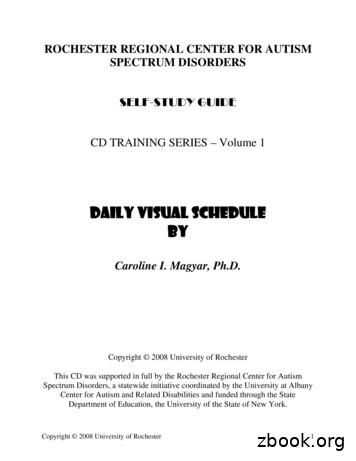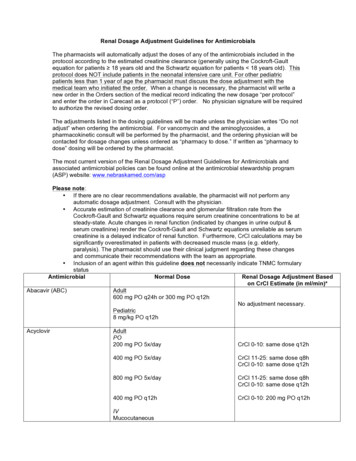LRBI Checklist Structured Daily Schedule Structured Daily .
LRBI ChecklistStructured Daily ScheduleStructured Daily ScheduleDefinitionAstructured daily schedule is a daily outline ofclassroom activities designed to maximize student learning. Structuring time through a planneddaily schedule of specific activities and transitionsmaximizes “on task” (i.e., engaged) behavior andminimizes students’ inappropriate behavior. Thedaily schedule must be followed and a sufficientnumber of staff must be present to make high ratesof on-task behaviors feasible.Things to Do List school activities overwhich you have no control. Identify nonacademic butnecessary tasks. Schedule instructionalactivities. Develop the schedule. Post the schedule. Present/review the schedule. Stick to the schedule. Clearly communicate anychanges.Preliminary Strategies1
LRBI ChecklistStructured Daily ScheduleListList schoolschool activitiesactivities overover whichwhich youyou havehavenono control.control.Determine the times for activities during the school day that cannot change such as lunch,recess, or physical education.IdentifyIdentify nonacademicnonacademic butbut necessarynecessary tasks.tasks.Such activities might include taking roll, collecting lunch money, sharpening pencils, announcements, flag salute, getting drinks, and going to the restroom. As these activitiesreduce instructional time, they must be carefully considered in the daily schedule.ScheduleSchedule instructionalinstructional activities.activities.Determine the specific instructional activities that must take place during the day. Estimatethe time required to carry out each task.DevelopDevelop thethe schedule.schedule.Considering the time needed for the activities identified in Steps 1-4, develop an activityschedule which meets the goal of 70% instructional time. The order in which you scheduleactivities is another important consideration. Some tasks might be better accomplished inthe morning—others in the afternoon; difficult tasks may seem more approachable followingsimpler activities or may be best gotten out of the way with more enjoyable tasks as a reward. These tasks will need to be determined by the teacher, since different students willhave different preferences.TimeConsider TransitionPreliminary StrategiesA great deal of instructional time is wasted whenthe transition between activities is not planned ormanaged efficiently. Expectations of studentbehavior during transitions should be specificallytaught, practiced, and reinforced. Minimizetransition time by: having materials organized and ready beforeeach activity; cueing students 5 minutes before the end of anactivity;2
LRBI Checklist Structured Daily Schedulemonitoring students during transition time and praising those who move quickly;“I like the way Danny and Billy got their books, went to the table, and are waitingquietly for me”); and planning activities at which students succeed so that they will be enthusiastic about thenext activity.PostPost thethe schedule.schedule.Post the schedule of daily activities or class periods in a conspicuous part of the room. Makecertain the print is large enough to be seen from any part of the room. Secondary studentsshould receive a copy of the schedule for their notebooks.For very young students or students with moderate to severe language or reading deficits, a“picture” schedule can be used with photographs of each activity or a series of clock faceswith one-word descriptions are effective alternatives, as well.Regardless of students’ language or reading level, some type of daily schedule should beposted. Individual schedules can be posted next to the main schedule for variable activities.Present/reviewPresent/review thethe schedule.schedule.Make certain that students understand the schedule. Telling them is not enough. Review theschedule several times before assuming they know the routine. Initially this may require adaily review. Question them about the schedule, role play examples and nonexamples ofexpectations regarding the schedule, and give students an opportunity to ask questions.StickStick toto thethe schedule.schedule.Once the schedule has been explained and posted, stick with it! Time for a particular activitymay vary, but stay with the overall routine.ClearlyClearly communicatecommunicate anyany changes.changes.Once a schedule has been established, do not hesitate to make changes if it is not workingsatisfactorily. When making changes, post copies of the revised schedule and make certainstudents understand the new routine.Preliminary Strategies3
LRBI ChecklistStructured Daily ScheduleExampleExampleThe following is an example ofan elementary class schedulewhich provides for academicallyscheduled time more than 70%of the day, accounts for set andvariable activities, transitions,and morning attentiveness.Daily Schedule8:15 – 8:30Homeroom/Reading8:30 – 9:15Language Arts9:15 –10:00Math10:00 – 10:15Recess10:15 –11:00History11:00 –11:45Science11:45 – 12:15Lunch12:15 –12:30Great Books12:30 – 1:15Media/Computer1:15 – 1:45Physical Education1:45 – 2:40Cooperative Learning2:40 – 2:45Clean-Up/DismissVariationsVariations ofof thethe TechniqueTechniqueWhile a set daily schedule is desirable, ateacher may wish to allow students choices(e.g., which task to do first) during certaintimes of the day when a choice is acceptable.PotentialPotential ProblemsProblems andand SolutionsSolutionsRestlessStudents May BecomeToo Much VarietyPreliminary StrategiesStudents may become sleepy, bored, or inattentiveduring prolonged periods of inactivity. Consider thelevel of physical activity during the day, particularlywith the younger students. Plan for some physicalactivity every 40 minutes or so, even if it is only tostand and stretch or get a drink. Be certain thatstudents also have time during their day for physical games and more strenuous activity.Beware of too much variety in the schedule.Students typically do better with an establishedroutine. Too little variety, on the other hand, willmake the classroom a boring place to be.4
LRBI ChecklistStructured Daily ScheduleGettingGetting ReadyReady Ensure that the classroom has a large wallclock to help students learn to managetheir time and follow the schedule. Plan to schedule instructionaltime for at least 70% of theschool day. Each studentshould be on task a minimum of 85% of that time.If not, the teacher needs tohelp the student increase his/her on-task behavior. For students with severe disabilities, a specific“attending” program may be needed.Examples of ways to systematically increaseon-task behavior include the use of a timedsystem, such as a “beeper tape” for differential reinforcement, or a combination ofa token economy and response cost(see LRBI—Level 1 and 2).schedule a daykeeps off-taskbehavior away.sMaterials and Supplie Select tasks at which students can perform with atleast an 80% success rate.Ensure sufficient staff areavailable to make high ratesof on-task behavior feasible.ClockLarge posterboard or space to display schedule.ReferencesReferencesAlgozzine, B., & Ysseldyke, J. (1992). Strategies and tactics for effective instruction.Longmont, CO: Sopris West.Hofmeister, A., & Lubke, M. (1989). Research into practice: Implementing effective teachingstrategies. Boston: Allyn and Bacon.Kerr, M. M., & Nelson, C. M. (1983). Strategies for managing behavior problems in theclassroom (2nd ed.). Columbus, OH: Merrill Publishing.Paines, S. C., Radicchi, J., Rosellini, L. C., Deutschman, L., & Darch, C. B. (1983). Structuring your classroom for academic success. Champaign, IL: Research Press.Preliminary Strategies5
schedule several times before assuming they know the routine. Initially this may require a daily review. Question them about the schedule, role play examples and nonexamples of expectations regarding the schedule, and give students an opportunity to ask questions. Present/review the schedule.Present/review the schedule.Present/review the schedule.
LRBI Checklist In-School Suspension (ISS) Level II 4 When a student’s misbehavior qualifies for ISS, follow these steps: Conduct in-school suspension.Conduct in-school suspension.Conduct in-school suspension. Arrange for students to work on class assignments while in ISS. Of
LRBI Checklist Data Collection Preliminary Strategies 5 Event recording is usually the method of choice when the teacher wants to increase or decrease a behavior. To use event recording, the behavior must be observable and have a clear beginning as well as a clear ending. Strengths Only nee
Daily Schedule Template . Daily Schedule Example . Daily Schedule Example Using Stickie Notes . Morning Meeting Checklist Example . Guided Reading Time Checklist Example . Math Time Checklist Example . Monthly Schedule Template . Monthly Schedule Example . College Weekly Schedule Template
Manager Opening Checklist Line Check Prep Checklist Station Setup Bar Opening Checklist Closing Checklist Host Opening/Closing Checklist Multi‐unit Inspections Checklist Periodic Maintenance Checklist Permits & License Review Staff Reviews/Evaluations
Increase knowledge of how a daily visual schedule can assist an individual with an autism spectrum disorder to be more independent – Learn the process for . assessing. the need for a daily visual schedule – Learn the steps to . developing. a daily visual schedule – Learn how to . teach. following a daily
400mg daily w/food With TDF, H2RA or PPI: ATV RTV 300/100mg daily w/food With EFV: ATV RTV: 400/100mg daily w/food Pediatric 6yr: 15-24kg; ATV RTV 150/80mg daily; 25-31kg: 200/100mg daily; 32-38kg 250/100mg daily; 39kg 300/100mg daily w/food 13yr, 39kg and unable to tolerate RTV: ATV 400mg daily w/food Experienced Adult
2.2 Daily Deal Services Many daily deal companies are using Twitter for business. Daily deal sites offer customers daily discounts, called deals, on products or services. The daily deal business model is increasing in popularity, and more than 200 daily deal companies exist in the United States as of December 2010. Groupon and LivingSocial
Black holes are physical objects in space, just like everything else we see in the night sky. But they pack so much mass into so small a space that not even light can escape their gravity. Radiation Cone Black Hole Accretion Disk. Known black holes fall into two classes: Stellar mass: 5 to tens of times the Sun’s mass Supermassive: 100,000 to billions of times the Sun’s mass .























